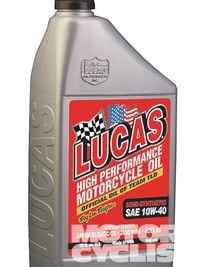Got a question for Answers? Send it to mcmail@sorc.com
Cooling-Off Period
Checking tire pressure is part of my pre-ride inspection, but how should I properly inflate a warm tire that lost a bit of air during a ride? Should I wait a prescribed period of time to let the tires cool off or use the other tire to determine relative inflation?
Chris Wantuch
Sugar Grove, IL
According to our friend Shawn Bell, Tire Development Engineer at Dunlop, pre-ride pressure checks with a reliable gauge are the most important tire maintenance you can do. “Underinflated tires mean imprecise cornering, irregular tread wear, overstressing and fatigue cracking, which can cause accidents and injuries,” he says. “The rear tire typically works harder, resulting in higher running temperatures, so air pressure will increase approx 1-3 psi more in the rear than in the front immediately after riding.
“It’s nearly impossible to define a prescribed cool-off period, since the time required is entirely dependent on the type of riding and environmental conditions,” Bell continues. Parking in a shaded area and putting your hand on the tread area will give you a reasonable idea. A properly cooled tire shouldn’t feel noticeably warmer than the surface it’s sitting on.
“Pressure should be within 1 psi of your pre-ride check,” Bell adds. “Any further pressure loss may be due to worn or improperly seated valve cores. A metal or hard-plastic valve cap with an inner gasket installed finger-tight will protect the valve core, helping to maintain a positive seal.”
Whenever your gauge indicates that you're losing air, check for punctures, cuts, abrasions, cracks, bulges or blisters. Check for damage to the rim as well. Beyond that, have your dealer dismount the tire and check for internal damage. The bottom line is you shouldn’t be losing pressure during a ride, so keep looking until you find the cause.
Tubeless Spoken Here
After 20 years on BMWs I went back to basic motorcycling, purchasing a Triumph T100. I love the bike, but I now feel somewhat limited in the distance I want to travel. Plugging a tire at the side of the road is nothing compared to patching a tube. Is there a safe way to convert wire-spoke wheels to use tubeless tires?
Ken Goergen
Cleveland, OH
Various shops will coat the insides of your wheels with a sealant to make them airtight for around $200, allowing you to mount a set of tubeless tires. The procedure seems to work well enough on automobiles, but there’s no telling how long it will remain airtight on a motorcycle. Not worth the risk if you’re asking us. The best solution for your bike would be a bespoke (sorry…) Alpina STS tubeless conversion kit (www.alpinawheelsusa.com) consisting of specially machined rims complete with spokes and trick, anodized-aluminum STS nipples, each with its own O-ring seal and retaining clip. The conversion improves handling and saves about 3 lbs. of precious unsprung weight, leaving the $980 price (not including installation) as the only potential downside. That’s still a lot less than a set of brand-new wheels, which is essentially what you’ll end up with.
Zinc Deficiency
I have a 1988 Honda NT650 Hawk GT. I have seen ads for oil additives containing zinc for cars built before 1989 because older camshafts and lifters are supposedly prone to premature wear with currently available automotive oils. Is this something that I should be concerned about with my bike? I'm only using motorcycle oil at present.
Ron Sakamoto
Bel Air, MD
Don’t worry. Zinc compounds in your oil are there to protect against potential metal-on-metal mayhem. According to Mark Negast, Technical Director at Lucas Oil, older cars with flat-tappet cams and lifters need more zinc to prevent metal-on-metal contact and premature wear. Since your Honda lubricates its engine and clutch with the same oil, Negast says stick with what you’re using. A little zinc additive is okay if it makes you feel better. Just make sure you’re not adding super-slippery friction modifiers that can make that clutch slip. Otherwise, a fresh filter and 2.4 quarts of 10W-40 every 4000 miles should keep that little bird singing for years to come.
Stay Cool | FAQ
After sitting in the garage all winter, my bike doesn't run quite as cool as I remember. Embarrassing as it is to admit, I can't remember the last time anything below the radiator cap got any love in the garage. There's coolant in there, but it's probably pretty old. What's the best thing to do now that the weather is turning and starting to warm up?
_Job one is to replace what’s in there with fresh stuff. The typical 50/50 mix of distilled water and coolant turns acidic enough to corrode engine internals over time. Additives meant to prevent rust and lubricate your water pump also deteriorate. Make sure the engine is cool. If what comes out is closer to brown than green, flush the radiator to remove sediments. And handle that stuff with care: Ethylene glycol is toxic and must be properly disposed of. Unless you’re going with a ready-to-use product like Pro Honda HP or Maxima Cool-Aide, mix distilled water and coolant ahead of time. Since water is the superior heat-disposal medium, don’t use more than 60 percent coolant. _















/cloudfront-us-east-1.images.arcpublishing.com/octane/FZXHNOQRNVA3BIDWAF46TSX6I4.jpg)
/cloudfront-us-east-1.images.arcpublishing.com/octane/JRSFLB2645FVNOQAZCKC5LNJY4.jpg)
/cloudfront-us-east-1.images.arcpublishing.com/octane/ITNLTIU5QZARHO733XP4EBTNVE.jpg)
/cloudfront-us-east-1.images.arcpublishing.com/octane/VZZXJQ6U3FESFPZCBVXKFSUG4A.jpg)
/cloudfront-us-east-1.images.arcpublishing.com/octane/QCZEPHQAMRHZPLHTDJBIJVWL3M.jpg)
/cloudfront-us-east-1.images.arcpublishing.com/octane/HXOUJXQWA5HBHGRO3EMJIGFMVI.jpg)

/cloudfront-us-east-1.images.arcpublishing.com/octane/3TIWWRV4JBBOLDVGRYECVVTA7Y.jpg)
/cloudfront-us-east-1.images.arcpublishing.com/octane/KIX5O23D5NAIBGFXBN3327DKZU.jpg)
/cloudfront-us-east-1.images.arcpublishing.com/octane/7GJYDUIPXRGMTMQKN6ONYOLBOU.jpg)
/cloudfront-us-east-1.images.arcpublishing.com/octane/MUQLOVLL2ZDGFH25ILABNBXKTI.jpg)
/cloudfront-us-east-1.images.arcpublishing.com/octane/TNOU5DNE2BC57MFPMGN2EIDXAM.jpg)
/cloudfront-us-east-1.images.arcpublishing.com/octane/GTCXACQGJ5HAPDTGWUQKDEH44E.jpg)
/cloudfront-us-east-1.images.arcpublishing.com/octane/S35YGSEMEZB4BLTDJTSZPF4GLA.jpg)
/cloudfront-us-east-1.images.arcpublishing.com/octane/5UOT6HPX2JFMRJAX6EH45AR4MQ.jpg)
/cloudfront-us-east-1.images.arcpublishing.com/octane/OKWOJWAKP5EP3OACCRRWPCIX2Q.jpg)
/cloudfront-us-east-1.images.arcpublishing.com/octane/2WF3SCE3NFBQXLDNJM7KMXA45E.jpg)
/cloudfront-us-east-1.images.arcpublishing.com/octane/G4MG6OUCJNBSHIS2MVVOTPX65E.jpg)
/cloudfront-us-east-1.images.arcpublishing.com/octane/IIGGWFOTOJGB7DB6DGBXCCMTDY.jpg)
/cloudfront-us-east-1.images.arcpublishing.com/octane/QSTCM6AVEZA5JJBUXNIQ3DSOF4.jpg)
/cloudfront-us-east-1.images.arcpublishing.com/octane/U4I7G625B5DMLF2DVIJDFZVV6M.jpg)
/cloudfront-us-east-1.images.arcpublishing.com/octane/B6XD6LS6IVCQPIU6HXDJSM3FHY.jpg)
/cloudfront-us-east-1.images.arcpublishing.com/octane/ICL63FEDDRDTTMINYICCEYGMDA.jpg)
/cloudfront-us-east-1.images.arcpublishing.com/octane/FCGZHQXRBZFLBAPC5SDIQLVF4I.jpg)